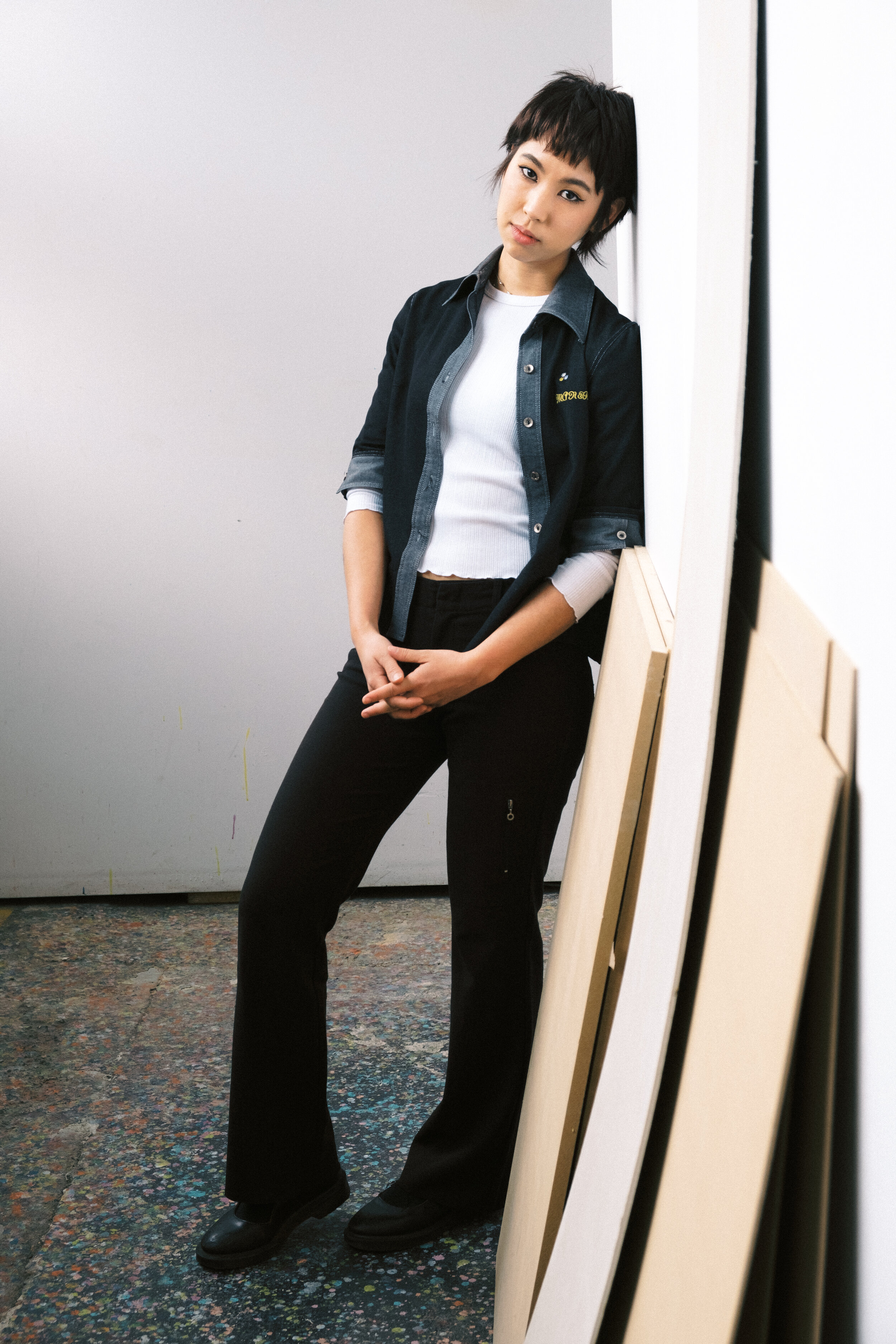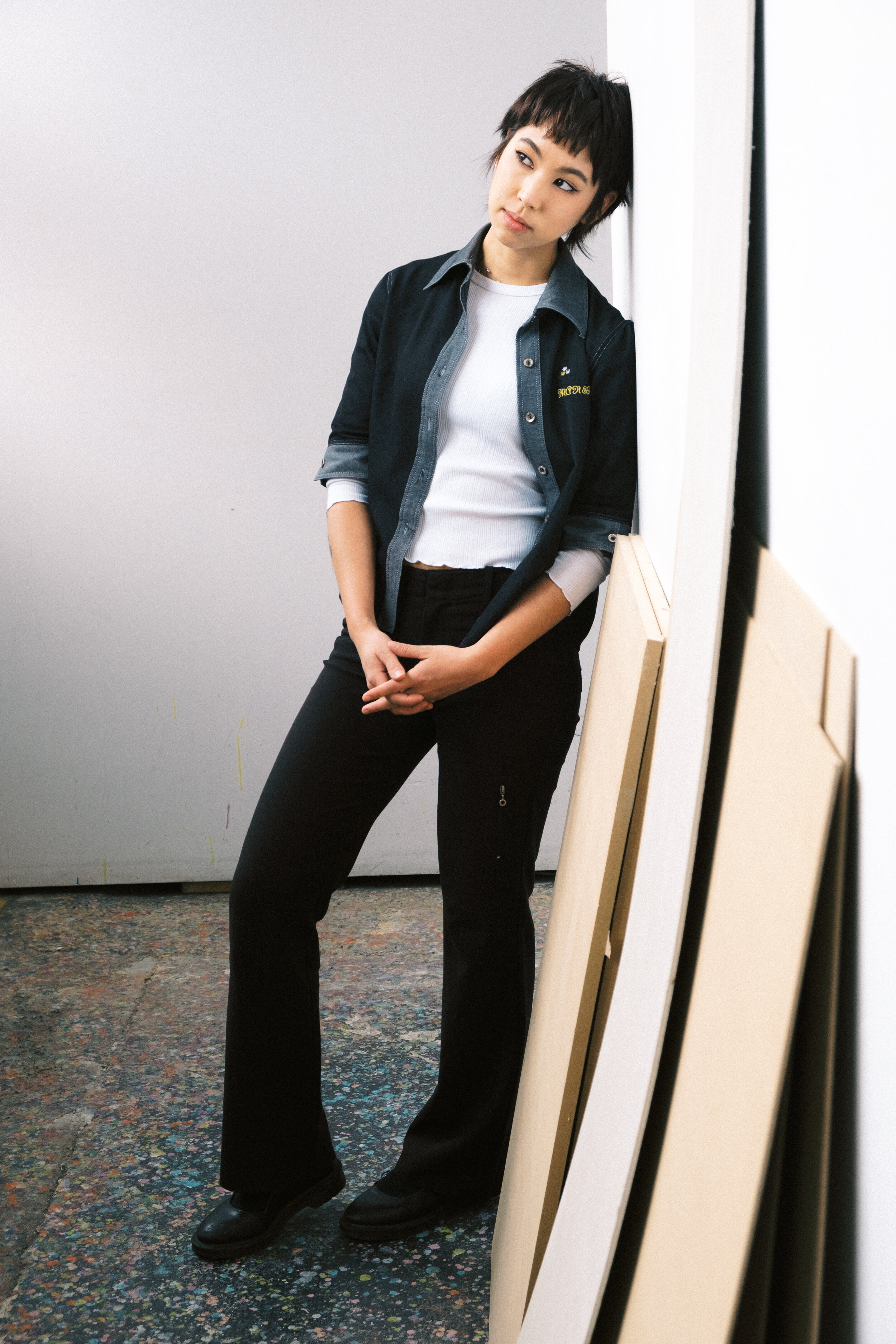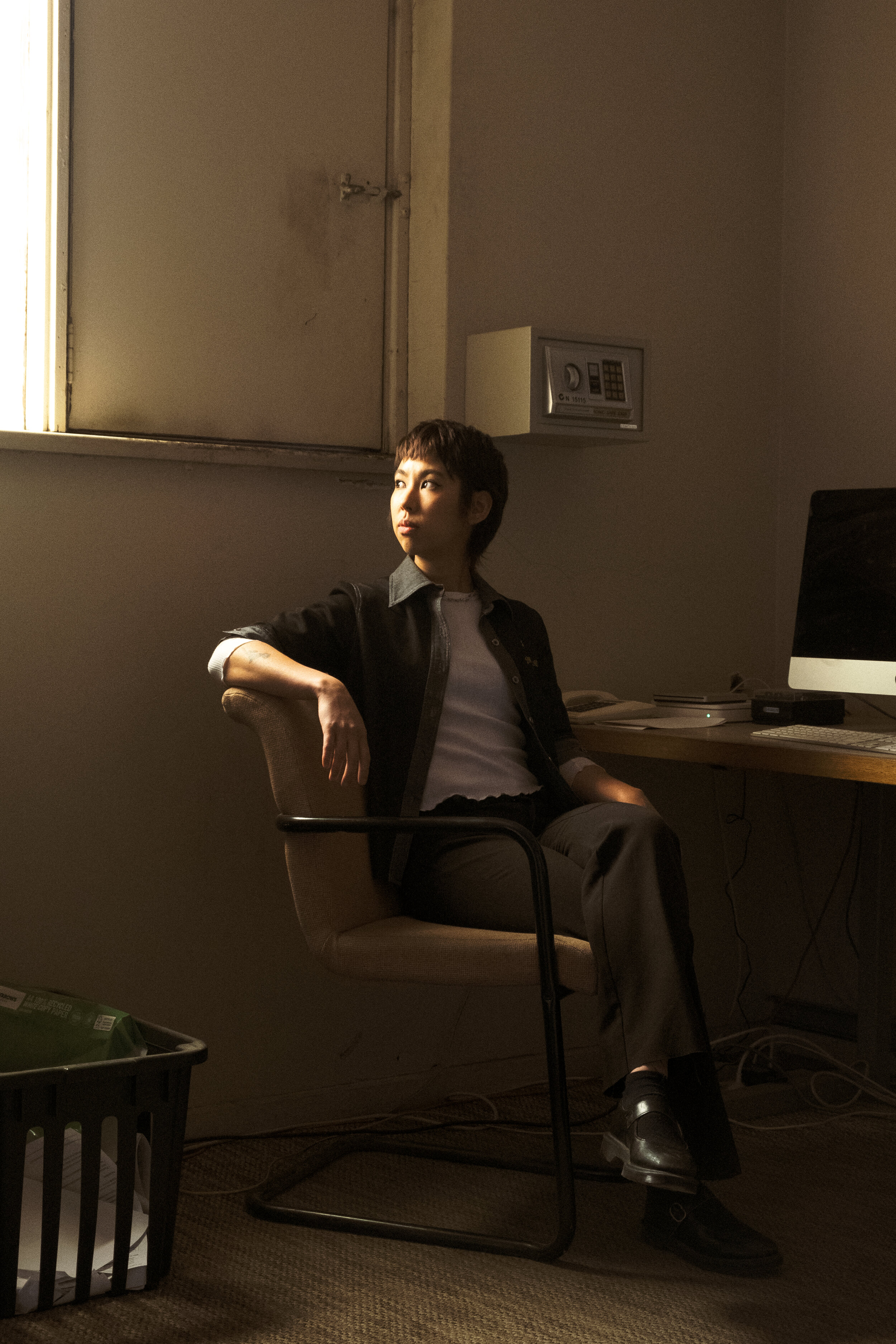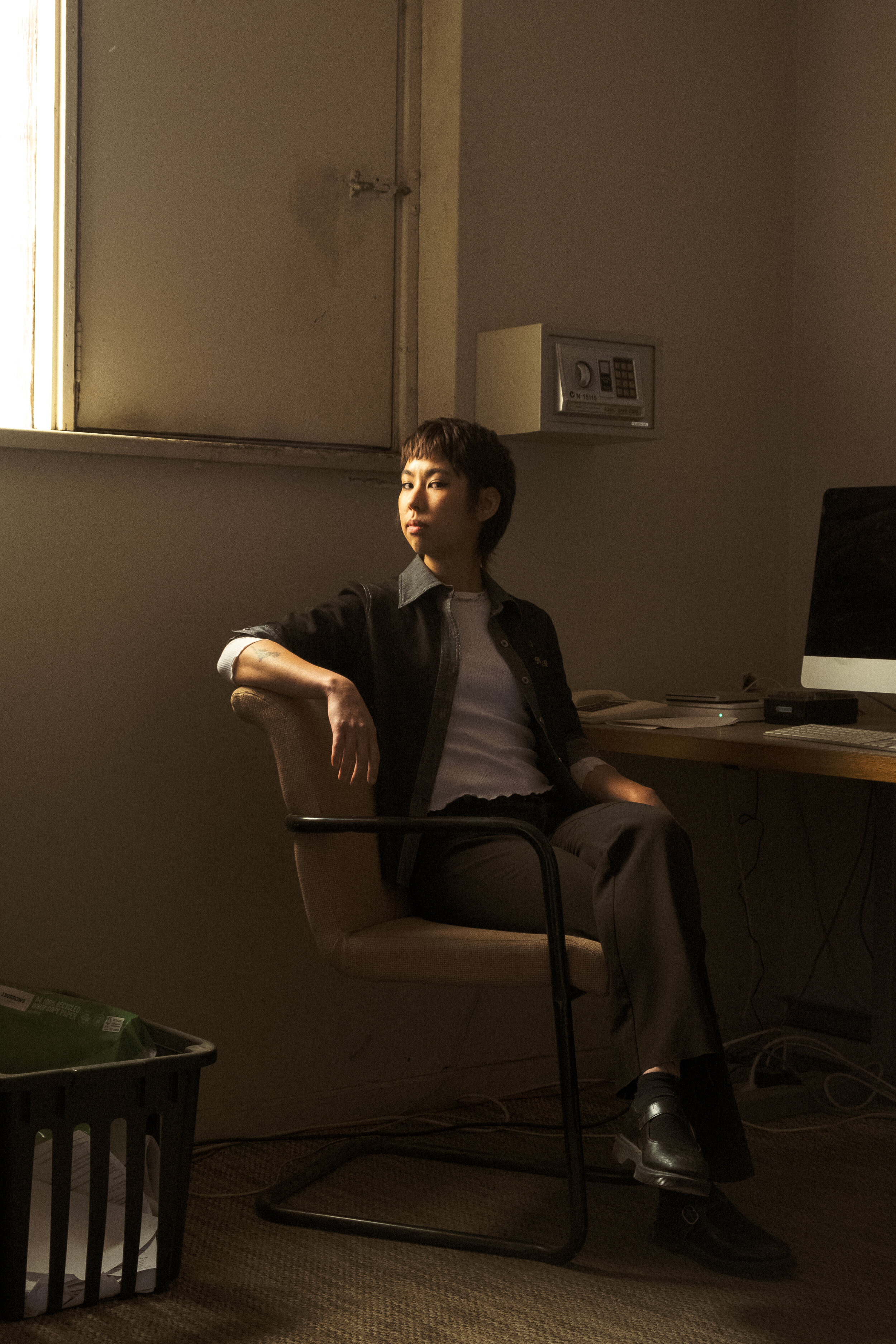Interview #124 — Lorilee Yang
by Panda Wong
Lorilee Yang is an artist currently based in Melbourne/Narrm. Her work explores nuanced themes surrounding identity, such as the diasporic experience—this exploration stems from her Chinese-Malaysian-Australian heritage.
She is currently interested in the legacy of myth and the narrative potential of painting to connect with her ancestral background.
Lorilee speaks to Panda Wong about painting as a form of translation, mythmaking and the pursuit of a sustainable practice.
How did you become an artist? Was there any specific point in your life where you realised this was what you wanted to do?
I don’t think there was an epiphany or a specific point in my life where I realised that I wanted to be an artist. Because my mum is a painter, self-expression through art felt like a natural extension. When I decided to go to university, I tossed up between studying graphic design and fine art. My sister told me something that was really influential to me at the time. She said, ‘You can do whatever you want, you just have to pick whichever you want to do first.’ Which is to say, if you have the means to—why not chase your passions? So, I picked art.
Tell me about your practice.
I’m predominantly a painter. My interest in identity stems from a desire to unpack and explore the intersections of identity that I occupy. I have been looking into the diasporic experience within the globalised world which incorporates topics such as history, myth, cultural symbolism, place and placelessness. A large part of my painting practice involves drawing upon collective emotional and mnemonic wells. In the past, I expanded on the idea that globalisation and normalised societal structures seek to homogenise and flatten cultural identities. In recent years, I have kind of been exploring the opposite sentiment to this by celebrating the perseverance of culture despite the overwhelming pressures of assimilation. Over time tackling topics such as globalisation and systemic whiteness can be really emotionally taxing. I think it’s really important to honour the points of difference that make you happy and feel proud of who you are. That act in itself is kind of anarchic lol.
You undertook an undergraduate degree in Fine Art at VCA—what was your experience with tertiary education?
I attended the VCA at a very formative time of my life. I had just graduated from high school and was very much still trying to work out who I was. Because I was jumping from one education system straight into another, I didn’t know anything outside of these institutions, which meant that I didn’t know how to demand the support that I needed. There are so many restrictions within academia and while it may seem more liberal, art school is still an institution. At that time, I didn’t yet have the vocabulary to express my personal experiences or even understand that they had any value or merit, particularly in comparison to the theoretical texts we were being taught.
Being able to do creative work is such a privilege in many ways, and not everyone can pursue an art practice. Understanding this is important because it explains why the majority of my peers and lecturers were white. Certain voices get prioritised over others. Certain artists and art movements get referenced more than others. When you can’t relate, you can go through a lot of internalised criticism—my method for coping with this was to become as independent as possible. It wasn’t until after leaving art school that I started reading texts by POC and seeking out community. It’s like… you don’t know what a safe space feels like until you do. Suddenly you can express your most authentic self because your approach to creating becomes something you do for yourself rather than for anyone else.
Because my mum is a painter, self-expression through art felt like a natural extension.
We’ve spoken previously about how you spent a year abroad in New York in 2015 and how that ended up being a year of not-painting. How do you think this break from painting has shaped your current practice?
My year abroad was definitely an educational experience. Being based in New York for a long time meant that I was able to see a lot of different exhibitions. Because Australia is so isolated, seeing work in the flesh rather than through a screen was a completely new and different experience for me. I think that when there is so much distance, we tend to canonise (white, male) artists, which isn’t conducive to inspiring new dialogues or encouraging the creation of challenging work. Taking a break from painting also allowed me to approach art from a different perspective.
Rather than consuming art to use it for personal development or inspiration, I was able to simply appreciate it for what it was. It sounds really corny, but this distance helped me to understand the potential power of art as a medium for communication. In every aspect of our lives, it feels like there is so much importance placed on having an outcome or being productive. As a visual artist, it can feel like you aren’t being productive or working until you have a physically tangible object, however, it’s just as necessary to spend time just thinking, reflecting and looking. Moving to New York was the first time I took a break from painting, which gave me a lot of space for reflection and to just exist as a human in the world! Art needs to come from life.
I’m interested in how your art-making process has helped you engage with your diasporic experience. What are your thoughts on that?
Art is a tool that helps me make sense of the world—it’s a means of digesting information, and the act of painting can be a form of research in itself. Consuming information, stories, symbols, images and then regurgitating them onto a canvas can be a method to place yourself in relation to the big things. I find it incredibly hard to put my diasporic experience into words because it’s made up of so many conflicting and nuanced threads. This way, artmaking is great for me because it allows me to explore disparate themes without the limitations of written or verbal language. It’s a form of translation. I like that the relationship between the viewer and the artwork is also like this additional act of translation. The viewer will always bring their subjectivity to an artwork which allows for the work’s meaning to remain fluid and unfixed. That’s important to me, especially when opening up discussions about diaspora because there is no singular, universal experience.
A common thread that runs through your work is the use of mythology and folklore, such as the use of the phoenix or the myth of Chang’E (the woman who lives with the rabbit in the moon) for example. For me, it feels like this act of translation that we touched upon earlier. How do you think mythmaking functions in your practice?
I’m fascinated by myth because it’s a way of binding together the past and present by establishing a sense of continuity. I’m always looking for threads of commonality and love the fact that stories can be centuries old. I wasn’t raised with knowledge surrounding my Chinese-Malaysian ancestry. It’s something that I have had to educate myself with now as an adult. I’ve found reading myths to be a really good entry point into learning about Chinese culture because they contain so much symbolism. There’s a lot of importance placed on things such as family and values. A lot of Chinese myth, symbol and superstition stem from the phonetic and written language so once you start looking into one aspect such as storytelling, you find that a lot of other things begin to unspool.
Myths are very foundational—every culture has myths about things like how people came to be or why the moon exists. I recently made a painting with an organ player which is representative of the goddess from Chinese myth— Nüwa. She’s attributed to being the ancestor of humankind. She made people because, even though the world was really beautiful, she felt indescribable loneliness. She shaped people out of mud in her image and gave them the name ‘人’. It’s also just nice to learn Chinese myths as an alternative to you know, Greek myths, that we are more familiar with. Being able to learn about alternate myths feels very empowering in the sense that they can give you another frame of reference.
But myths aren’t limited to the folklore that was established a long time ago. We are constantly forming and upholding new myths. For example, nostalgia is a form of personal mythmaking. Or maybe you grew up with a familial myth, such as your ancestor’s migration story. We adhere to societal myths every day.
Art is a tool that helps me make sense of the world—it’s a means of digesting information, and the act of painting can be a form of research in itself.
Your show at c3 ‘I Can Stand Tall In This Shallow Well’ had a piece written by Chi Tran and in previous shows, other writing (including your own!) accompanied your work. Can you expand on the relationship between writing and painting?
I find poetry to be really inspirational, particularly because of its imagery elements. I think that painting and poetry are really harmonious because both forms lend themselves to subjectivity. Because the conventions of language can be removed, there’s a lot more freedom to form new meanings outside of the confines of words. I love Chi’s writing because they delve deeply into this concept of language as a non-fixed thing.
Writing provides a way for people to approach an exhibition from a different perspective. It can be really important in that it can give context or give the artwork another layer - it’s another entry point into the work. Can we take a moment to acknowledge that you’ve created a text for me in the past! You wrote an ekphrastic poem that accompanied my show ‘To arrive upside down’. That was a really wonderful experience which felt very collaborative and your poem helped articulate these myths that we spoke about earlier to a wider audience.
For my show ‘I Can Stand Tall In This Shallow Well’, I wrote this poem—here is part of it:
‘…please don’t ask me to absolve you of the gnawing that comes from deep within your chest, find another to feed your thoughts. I am the rightfully ordained heir to the peach blossom spring.’
Sometimes as an artist of colour, you can feel tokenised. There’s the niggling feeling that your representation is simply there to satisfy the white gaze. While having an exhibition means taking up space in a scene that is overwhelmingly, historically white, sometimes you need the additional explicitness of language to set boundaries.
There is a really strong sense of joy, play and humour that emanates from your work. I’m obsessed with this painting from ‘ITCHY’, a group show you were part of at SEVENTH Gallery. The painting is of a big happy dog scratching itself in an idyllic and sun-drenched meadow. It feels like even when the subject of your work isn’t necessarily joyful that you manage to always evoke a sense of warmth and optimism. Do you think that this is a conscious effort?
Humour is definitely a large part of my working process. If you don’t laugh, then you’ll just cry. It can be a really great way to deal with things that feel traumatic at times, or hard to tackle head-on. When I’m painting, it’s like I’m telling myself jokes even though I don’t know if anyone else will find them funny. I also just genuinely find a lot of joy in the act of painting so I’m glad that this carries through!
‘ITCHY’ was also your first curatorial venture. I was a participating artist and it was fascinating to see how you fleshed out the show—from conceiving a theme to plotting out the space to the curation of the artists. How did you find your debut curatorial experience?
Curating was a completely new and different experience. It made me realise how much responsibility and power a curator has because you are choosing which artists are being given a platform. The most satisfying thing about curating this show were the dialogues between myself and the other artists. I loved having the opportunity to open up a generative conversation with some amazing people.
What’s your view of the Australian art scene? What hopes do you have for it?
I think Australia still has a long way to go regarding diverse representation. I do believe that things are changing now that conversations have opened up, however, the very premise of diversity is that exists within being other. It still upholds and centralises society’s dominant voices. It’s difficult to know whether representation is performative or genuine. For change to be something real and lasting it’s something that needs to happen structurally.
What’s next for you?
I’ve had a really busy couple of years, making work going from deadline to deadline. Having recently emerged from that, I’ve had the space to breathe and reassess where it is that I want to go next within my practice. Right now, I’m planning a self-directed residency to stay for a couple of weeks in Beijing. I don’t know what the outcome of this is going to be, but I feel like it will be a really pivotal experience for me, like a homecoming of sorts. I’m also wary of the fact that I will still very much be an outsider. It’ll be good to explore the things I’m looking at in a different environment and exist outside of a Western society for a while anyway.
Humour is definitely a large part of my working process. If you don’t laugh, then you’ll just cry.
Do you have any advice for emerging artists?
From one emerging artist to another: Don’t set limitations on yourself or let rejection get you down. There is no good that will come from comparing yourself to anyone else because, while you can follow the footsteps of others your path is entirely your own. Make work about the things you are passionate about and that work will speak for itself. Surround yourself with a community that makes you feel supported and inspired.
Who are you inspired by?
I’m inspired by so many people. I seek to surround myself with people that I find inspirational and so, because of this, I am constantly inspired by my friends.
What are you listening to?
I love listening to podcasts while I work. My forever favourite is Still Processing. Also, pop music—I have a shameless love for pop music.
What are you reading?
I’ve just begun reading We Need New Stories by Nesrine Malik. I’ve also been really into millennial fiction lately, like The New Me by Halle Butler and My Year of Rest and Relaxation by Otessa Moshfegh.
How do you practice self-care?
The term self-care as it’s commonly used today is severely co-opted from its origins. It isn’t applicable to me. I would prefer to rephrase this question as—how do you navigate upholding a sustainable, creative practice? Lately I have been trying to break down the barriers in my mind that link self-worth with productivity. It’s ok for things to ebb and flow. I’ve learnt that sleep and movement are things that are super important for my mental wellbeing. I find acts like cooking and gardening to be very healing.
What does being Asian-Australian mean to you?
It’s important to acknowledge that I am a settler on unceded land. Being (East) Asian-Australian means that I am a minority in this country as a person of colour, but at the same time, I have so many privileges. It means existing as a hybridised mix of cultures and being constantly aware of my differences but accepting that they are nonetheless full and valid.
Lately I have been trying to break down the barriers in my mind that link self-worth with productivity.
Find out more
Interview by Panda Wong
Photographs by Sarah Ruhullah







